
Overview of High-Pressure Cell System
The High-Pressure Cell (HP Cell) system includes the pressure cell, the pump, and the software for system control and data acquisition. It has been designed for absorption, fluorescence, Raman spectroscopy and polarimetry studies of solid and liquid samples. The cell, built in a stainless-steel alloy, reaches pressures up to 400 MPa (4,000 bar) using a hydrostatic pump. The HP Cell can be mounted directly into ISS spectrofluorometers and several commercial instruments; also, it can be used as a stand-alone unit.
The HP Cell comes either in a 3- or 4-windows version; the windows are located at 90 degrees from each other. Quartz and sapphire windows feature a 10 mm aperture; MgF2 windows (used for polarimetry studies) feature a 3 mm aperture.
The high aperture 10 mm-diameter windows allow for using as an excitation light source either a laser, a light emitting diode (LED) or a collimated beam from a xenon arc lamp. The unusually high numerical aperture (NA = 0.18) for a cell makes it unique for high sensitivity fluorescence studies.
Compatible with ChronosBH, ChronosDFD, and PC1.Electrical Feedthrough
A plug is available for the HP Cell whenever a voltage needs to be applied to a sample. The plug is mounted on top of the HP Cell; the pressure is applied by connecting the flexible tubing from the pump horizontally onto the plug. Pressures up to 300 MPa can be reached with the plug.
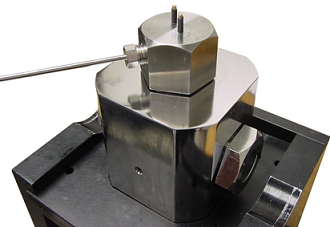
HP Cell with the plug for electrical feedthrough. The pressure is applied through the tubing connected horizontally to the plug. The voltage is applied on the electrodes.
Windows
Optical windows are made out of quartz (SiO2), sapphire (single-crystal aluminum oxide Al2O3) or MgF2. The windows are mounted onto polished plugs and held in place by precise mechanical holders.
| Material | Max pressure (MPa) | Aperture (mm) | Birifringence (Δn) | Transmission range (nm) |
|---|---|---|---|---|
| Quartz [SiO2] | 300 | 10 | +0.009 | 180 - 2,000 |
| Sapphire [Al2O3] | 400 | 10 | -0.008 | 250 - 5,000 |
| MgF2 | 250 | 5 | +0.006 | 150 - 6,500 |
The choice of the windows material is dictated by the specific application and measurement to be acquired. Quartz windows, constructed of UV grade fused silica, withstand pressures up to 300 MPa. Fused silica is a polycrystalline, isotropic material with no crystal orientation; these windows are suitable for polarization measurements. Sapphire windows withstand pressures up to 400 MPa. Yet, sapphire is a synthetic, hexagonal, single-crystal, anisotropic material, which displays substantially different optical characteristics when measured along different axes; sapphire if birefringent, that is a light beam propagating along the optical axis experiences two different values of the index of refraction. These windows are less suitable for polarization measurements. MgF2 windows feature the lowest birefringence; moreover, their transmission extends to 150 nm making them suitable for circular dichroism studies.
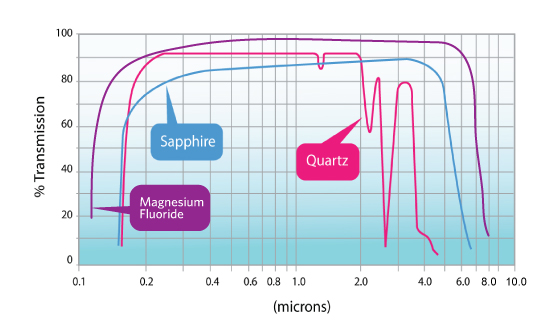
Temperature Control
The HP Cell body includes a built-in path for circulating the temperature control liquid from an external bath circulator directly attached to it. Since the cell is made of a stainless-steel alloy with excellent thermal conductivity, temperature stabilization is rapid. The HP Cell is designed for operating in the temperature range from -40 °C to 80 °C.
Product Specifications for High-Pressure Cell System
Cell
Pressure
- up to 300 MPa (3,000 bar) with quartz windows
- up to 400 MPa (4,000 bar) with sapphire windows
- up to 250 MPa (2,500 bar) with MgF2 windows
Temperature
- -40 °C to +80 °C
- Controlled through built-in liquid circulation circuit
- Thermal Conductivity
- 2 W • cm-1 • K-1 at 20 °C
- 16 W • cm-1 • K-1 at 200 °C
Windows
- Quartz (19 mm diameter x 8.5 mm thick)
- Sapphire (19 mm diameter x 6.4 mm thick)
- MgF2 (19 mm diameter x 8.5 mm thick)
Windows Aperture
- Quartz and Sapphire: 10 mm
- MgF2: 3 mm
Internal Cell Chamber
- Diameter: 22 mm
- Height: 50.3 mm
Dimensions
- 119 mm (W) x 105 mm (L) x 121.5 mm (H)
- 39 mm from base to window centers
Pressure Generator
Gauge
- Up to 600 MPa
Reservoir Volume
- 116 ml
Generator Volume
- 10 ml (manual or automatic pump)
Tubing
- 1/8" diameter, flexible up to 415 MPa
Thermocouple
- Either Ni-Cr-Ni or Fe-Const
Sample Holder Volumes
Empty Cell, 3 Quartz Windows
- 15.0 ml
Empty Cell, 4 Sapphire Windows
- 24.5 ml
Holder fitted with 11 mm bottle and cap
- 11.0 ml
- Max allowed height of bottle with cap: 40.0 mm
Round cuvette, 11 mm outer diameter
- 0.75 ml
Round cuvette, 9 mm outer diameter
- 0.80 ml
Square cell, 6 x 6 mm
- 0.30 ml
Hydrostatic Liquid
Pressure Media
- Spectroscopic-Grade Water
- Low Fluorescence Background Ethanol
Product Accessories for High-Pressure Cell System
Product Resources
-
“Response and adaptation of the transcriptional heat shock response to pressure.” Coffin, C.H., Fisher, L.A., Crippen, S., Demers, P., Bartlett, D.H., & Royer, C.A. Frontiers in Microbiology, 15, 2024, Nov. doi: 10.3389/fmicb.2024.1470617.
-
“Ions in the Deep Subsurface of Earth, Mars, and Icy Moons: Their Effects in Combination with Temperature and Pressure on tRNA–Ligand Binding.” Jahmidi-Azizi, N., Gault, S., Cockell, C.S., Oliva, R., & Winter, R. International Journal of Molecular Sciences, 22(19), 2021, Oct. doi: 10.3390/ijms221910861.
-
“The consequences of cavity creation on the folding landscape of a repeat protein depend upon context.” Jenkins, K.A., Fossat, M.J., Zhang, S., Rai, D.K., Klein, S., Gillilan, R., White, Z., Gerlich, G., McCallum, S.A., Winter, R., Gruner, S.M., Barrick, D., & Royer, C.A. PNAS, 115(35), pp. E8153–E8161, 2018, Aug. doi: 10.1073/pnas.1807379115.
-
“Targeting the Prion-like Aggregation of Mutant p53 to Combat Cancer.” Silva, J.L., Cino, E.A., Soares, L.N., Ferreira, V.F., & de Oliveira, A.P. Accounts of Chemical Research, 51(1), pp. 181–190, 2017, Dec. doi: 10.1021/acs.accounts.7b00473.
-
“Comparing Fast Pressure Jump and Temperature Jump Protein Folding Experiments and Simulations.” Wirth, A.J., Liu, Y., Prigozhin, M.B., Schulten, K. & Gruebele, M. Journal of the American Chemical Society, 137(22), pp. 7152–7159, 2015, Jun. doi: 10.1021/jacs.5b02474.
-
“Dual chamber shape memory alloy unplugging and mixing system coupled to a high pressure optical cell for biophysical studies.” Leist, S.K., Kunkle, C., Chong, P.L.G. & Zhou, J. Smart Materials and Structures, 24(3), 2015, Feb. doi: 10.1088/0964-1726/24/3/035014.
-
“Circular dichroism and site-directed spin labeling reveal structural and dynamical features of high-pressure states of myoglobin.” Lerch, M.T., Horwitz, J., Mccoy, J. & Hubbell, W.L. Proceedings of the National Academy of Sciences, 110(49), 2013, Nov. doi: 10.1073/pnas.1320124110.
-
“Pressure Modulation of Ras–Membrane Interactions and Intervesicle Transfer.” Kapoor, S., Werkmüller, A., Goody, R.S., Waldmann, H. & Winter, R. Journal of the American Chemical Society, 135(16), pp. 6149–6156, 2013, Apr. doi: 10.1021/ja312671j.
-
“Misplaced helix slows down ultrafast pressure-jump protein folding.” Prigozhin, M.B., Liu, Y., Wirth, A.J., Kapoor, S., Winter, R., Schulten, K. & Gruebele, M. Proceedings of the National Academy of Sciences, 110(20), pp. 8087–8092, 2013, Apr. doi: 10.1073/pnas.1219163110.
-
“Dissecting the Structure, Thermodynamic Stability, and Aggregation Properties of the A25T Transthyretin (A25T-TTR) Variant Involved in Leptomeningeal Amyloidosis: Identifying Protein Partners That Co-Aggregate during A25T-TTR Fibrillogenesis in Cerebrospinal Fluid.” Azevedo, E.P.C., Pereira, H.M., Garratt, R.C., Kelly, J.W., Foguel, D. & Palhano, F.L. Biochemistry, 50(51), pp. 11070–11083, 2011, Nov. doi: 10.1021/bi201365r.
-
“Refolding of endostatin from inclusion bodies using high hydrostatic pressure.” Chura-Chambi, R.M., Genova, L.A., Affonso, R. & Morganti, L. Analytical Biochemistry, 379(1), pp. 32–39, 2008, Aug. doi: 10.1016/j.ab.2008.04.024.
-
“Vi -Value Analysis: A Pressure-Based Method for Mapping the Folding Transition State Ensemble of Proteins.” Mitra, L., Hata, K., Kono, R., Maeno, A., Isom, D., Rouget, J.-B., Winter, R., Akasaka, K., García-Moreno, B. & Royer, C.A. Journal of the American Chemical Society, 129(46), pp. 14108–14109, 2007, Oct. doi: 10.1021/ja073576y.
-
“pH dependence of the dissociation of multimeric hemoglobin probed by high hydrostatic pressure.” Bispo, J.A., Santos, J.L., Landini, G.F., Goncalves, J.M. & Bonafe, C.F. Biophysical Chemistry, 125(2-3), pp. 341–349, 2007, Feb. doi: 10.1016/j.bpc.2006.09.009.
-
“Proton dependence of tobacco mosaic virus dissociation by pressure.” Santos, J.L., Bispo, J.A., Landini, G.F. & Bonafe, C.F. Biophysical Chemistry, 111(1), pp. 53–61, 2004, Sep. doi: 10.1016/j.bpc.2004.04.003.
-
“Pressure and temperature dependence of the melt segmental dynamics of cis-1,4-polyisoprene via time resolved optical spectroscopy.” Punchard, B.J. & Adolf, D.B. The Journal of Chemical Physics, 117(16), pp. 7774–7780, 2002, Oct. doi: 10.1063/1.1509450.
-
“Effects of Pressure-Induced Membrane Phase Transitions on Inactivation of HorA, an ATP-Dependent Multidrug Resistance Transporter, in Lactobacillus plantarum.” Ulmer, H.M., Herberhold, H., Fahsel, S., Gänzle, M.G., Winter, R., & Vogel, R.F. Applied and Environmental Microbiology, 68(3), pp. 1088–1095, 2002, Mar. doi: 10.1128/AEM.68.3.1088–1095.2002.
-
“Pressure and Temperature Dependence of the Dilute Solution Segmental Dynamics of Anthracene-Labeled Polyisoprene.” Punchard, B.J. & Adolf, D.B. Macromolecules, 35(8), pp. 3281–3287, 2002, Mar. doi: 10.1021/ma011783r.
-
“Time-resolved optical spectroscopy study of the local dynamics of cis-1,4 and vinyl-1,2-polybutadiene in dilute solution at high pressure.” Punchard, B., Kirpatch, A. & Adolf, D. Polymer, 43(23), pp. 6287–6293, 2002, Jan. doi: 10.1016/s0032-3861(02)00549-9.
-
“Unusual Properties of Highly Charged Buffers: Large Ionization Volumes and Low Barrier Hydrogen Bonds.” Hess, R.A. & Reinhardt, L.A. Journal of the American Chemical Society, 121(42), pp. 9867–9870, 1999, Oct. doi: 10.1021/ja9921726.
Compatibility
ISS provides the suitable baseplates for mounting HP Cell into several spectrofluorometers and spectrophotometers. If the high-pressure cell cannot be mounted into an instrument, fiber-optic bundles are utilized for connection. Please contact ISS for details on the fiber optics kit.
Spectrofluorometer mounting kits are available for:
| ISS | PC1 K2 ChronosBH ChronosDFD |
|---|---|
| AVIV | AFTF105 |
| Edinburgh Instruments | FS900 |
| Hitachi | F4500 |
| Horiba | Fluorolog 2, 3 Fluoromax 2, 3 |
| Jasco | FP-8300, FP-8500, FP-8600 |
| SLM | 4800, 8000, 8100, 48000 |
| Varian | Cary Eclipse |
Spectrophotometer mounting kits are available for:
| Jasco | V-750, V-760, V-770, V-780 |
|---|---|
| Shimadzu | UV2501PC, UV1650PC |
| Varian | Cary 14 UV/VIS, Cary 50, 100, 300 |
Spectropolarimeter mounting kits are available for:
| Jasco | J-710, J-715, J-810, J-815, J-1500, J-1700 |
|---|
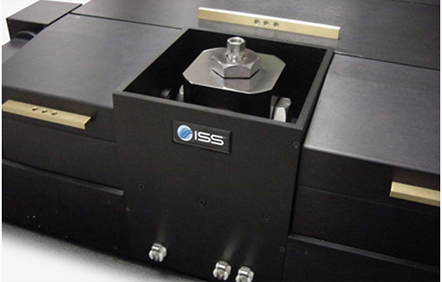

High-Pressure Cell in a PC1 spectrofluorometer by ISS
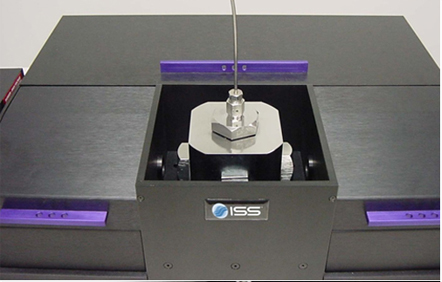

High-Pressure Cell in a ChronosDFD lifetime spectrofluorometer by ISS
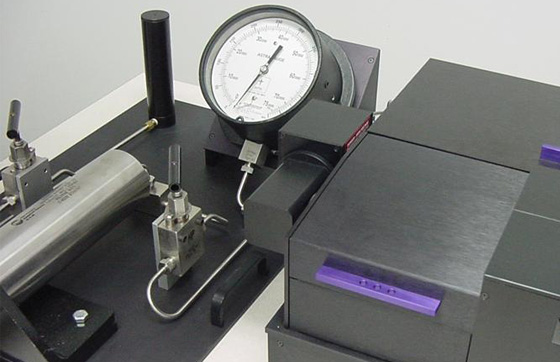

Manual pump close to a ChronosDFD by ISS
The high-pressure cell connects to a pressure pump.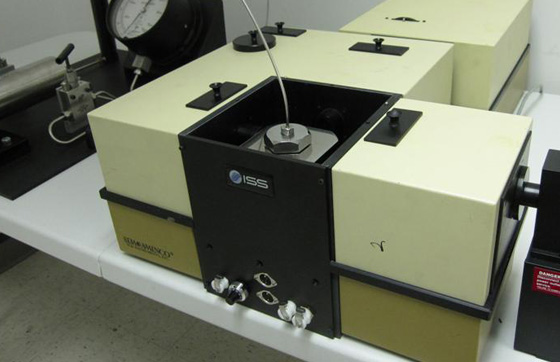

High-Pressure Cell in a Model 8100 spectrofluorometer by SLM
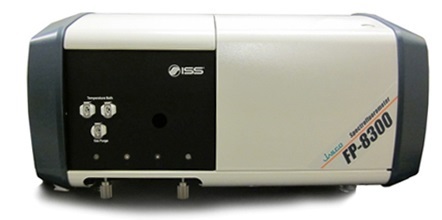

High-Pressure Cell in a Model 8300 spectrofluorometer by Jasco
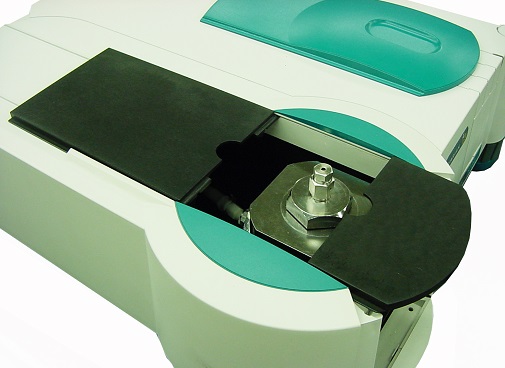

High-Pressure Cell in a Cary100 spectrophotometer by Varian
Lifetime Measurements
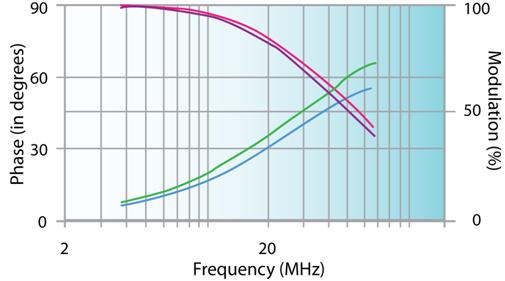
(Courtesy of Prof. Catherine A. Royer, Centre de Biochimie Structurale, Université Montpellier I, Montpellier, France)
Absorption and Emission Spectra
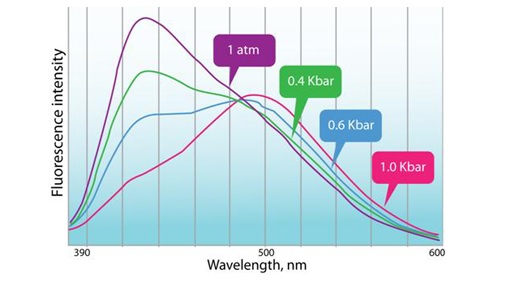
(Courtesy of Prof. Parkson L.-G. Chong, Temple University, Philadelphia, PA, USA)







